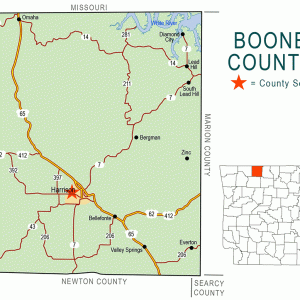calsfoundation@cals.org
Valley Springs (Boone County)
| Latitude and Longitude: | 36°09’27″N 092°59’35″W |
| Elevation: | 1,086 feet |
| Area: | 0.51 square miles (2020 Census) |
| Population: | 183 (2020 Census) |
| Incorporation Date: | August 5, 1929 |
Historical Population as per the U.S. Census:
|
1810 |
1820 |
1830 |
1840 |
1850 |
1860 |
1870 |
1880 |
1890 |
1900 |
|
– |
– |
– |
– |
– |
– |
– |
– |
– |
– |
|
1910 |
1920 |
1930 |
1940 |
1950 |
1960 |
1970 |
1980 |
1990 |
2000 |
|
– |
– |
– |
– |
– |
– |
– |
190 |
200 |
167 |
|
2010 |
2020 |
|
|
|
|
|
|
|
|
|
183 |
183 |
|
|
|
|
|
|
|
|
Valley Springs is located on U.S. Highway 65 in southeastern Boone County. Long a center of education, Valley Springs is a rural, agricultural town. Many of its residents work in Harrison (Boone County).
For centuries, people have traveled from the north to hunt and fish in Arkansas’s Ozark Mountains. The Osage were traveling to the area at the time of the Louisiana Purchase in 1803. Later, the Cherokee and other Native Americans were granted land in the area, but a subsequent treaty moved them farther west. A military road ran through the area, connecting Valley Springs (then known as Double Springs) to the cities of Harrison and Yellville (Marion County). A post office was established in 1843 near the two springs for which the area would be named, but the post office was called Rolling Prairie for twenty-six years. George Rowland was one of the first settlers to formally claim land near the springs, registering his land patent in 1854.
The springs were in Carroll County during the Civil War, as Boone County would not be created until 1869. Some men from the county fought for the Confederate states during the war, while others actively supported the cause of the Union. Some groups of outlaws took advantage of wartime confusion to pursue their own interests without loyalty to either government. Federal forces attempted to respond to the lawlessness in the area, forming a cavalry unit of about 600 men to face a force of about 2,000 Confederate fighters and bushwhackers. Around noon on January 23, 1864, a party of twenty-five Federal troops carrying dispatches was attacked by sixty enemies. Twelve of the Federal soldiers were killed, and another two were injured. No Confederate losses were ever reported from the incident, although the Federal forces returned fire and believed that casualties had resulted. The dispatches carried by the party ended up in Confederate hands.
After the war, and after the creation of Boone County, the population of the area began to grow. The name of the post office was changed from Rolling Prairie to Double Springs in 1869, and then changed again to Valley Springs in 1874. In 1873, a school called the Double Springs Seminary was established by the Methodist Episcopal Church. Boys and girls were taught in separate classrooms, taking courses in reading, writing, grammar, composition, arithmetic, algebra, geometry, geography, history, chemistry, astronomy, rhetoric, logic, Greek, and Latin, among other subjects. The school quickly gained a reputation for high academic standards. By 1886, the name of the school had been changed to the Valley Springs Academy.
In 1912, the North Arkansas Conference of Methodist Churches acquired the academy and started a high school, using the same facilities and retaining some of the faculty. It renamed the institution the Valley Springs Training School. In addition to a classroom building and a dormitory, the school owned 160 acres of farmland on which the students worked. In 1937, facing financial difficulties due to the Depression, the school was relinquished by the Methodists, and the property became a public school, renamed Valley Springs Consolidated School. A new building was erected by the Works Progress Administration (WPA) in 1941; that building is now on the National Register of Historic Places. In 1948, the Valley Springs School District was consolidated with those of Bellefonte (Boone County) and Everton (Boone County), with the main campus of the school district remaining in Valley Springs. Several waves of construction during the subsequent decades continued to improve the school property.
Between 1993 and 1996, Valley Springs was home to a military facility, the Electronic Combat Range Detachment. About sixty-five personnel of the U.S. Air Force under the command of Darrell Wilson trained at the facility, gaining experience in countering enemy radar systems and learning other electronic functions. When the unit was deactivated in 1996, its property was acquired by the Lockheed Martin Corporation. Experiments involving complex radar installations continue to be performed at the site by both the air force and Lockheed Martin; the latter maintains a civilian staff of twenty-five to thirty workers.
In the twenty-first century, Valley Springs supports a general store, a quarry, and several small locally owned businesses. The town has four churches: Baptist, Methodist, Community, and Assembly of God. The school district had more than 900 students in the 2013–2014 school year.
For additional information:
“About Our School History.” Valley Springs School District. https://www.valley.k12.ar.us/page/our-school-history (accessed November 21, 2025).
Boone County Historical & Railroad Society. History of Boone County, Arkansas. Paducah, KY: Turner Publishing Company, 1998.
Hicks, John C. “Movies Come to Spring Valley.” Boone County Historian 23 (July–September 2000): 55–57.
Hollabaugh, Dora. “Valley Springs Academy.” Arkansas Historical Quarterly 16 (Spring 1957): 78–83.
Steven Teske
Butler Center for Arkansas Studies
 Boone County Map
Boone County Map 



Comments
No comments on this entry yet.